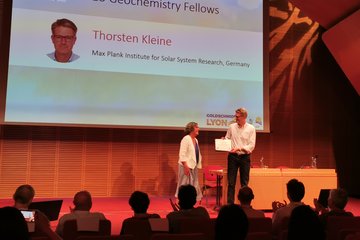Alle Typen
21.
Zeitschriftenartikel
Pickup ions ( E O+ > 55 keV) measured near Mars by Phobos-2 in February/March 1989. Annales Geophysicae 9, S. 761 - 767 (1991)
22.
Zeitschriftenartikel
Interplanetary variability recorded by the SLED instrument aboard the PHOBOS spacecraft during that period of solar cycle 22 characterized by a transition from solar minimum - to solar maximum dominated conditions. Planetary and Space Science 39, S. 47 - 56 (1991)
23.
Zeitschriftenartikel
Interplanetary variability in particle fluxes recorded by the low enrgy charged particle detector SLED (∼30 keV-30 MeV) during the cruise phase of the PHOBOS mission to Mars and its moons. Annales Geophysicae 9, S. 348 - 356 (1991)
24.
Zeitschriftenartikel
Interplanetary variability recorded by the SLED instrument aboard the PHOBOS spacecraft during that period of solar cycle 22 characterized by a transient from solar minimum - to solar maximum dominated conditions. Planetary and Space Science 38 (1/2) (1991)
25.
Zeitschriftenartikel
The low energy particle detector SLED (∼30 keV-3.2 MeV) and its performance on the PHOBOS Mission and its moons. Nucl. Instr. and Methods in Physics Research A290, S. 217 - 222 (1990)
26.
Zeitschriftenartikel
Energetic ions in the close environment of Mars and particle shadowing by the planet. Nature 341, S. 616 - 618 (1989)
27.
Buchkapitel
Lower cut-off energy of 3He-rich solar particle events ? In: Plasma Astrophysics and Space Physics, Proc. VIIth Int. Conf. held in Katlenburg-Lindau, Germany, May 4-8, 1998, S. 639 - 644 (Hg. Büchner, J.; Axford, I.; Marsch, E.; Vasyliūnas, V.). Kluwer Academic Publishers, Dordrecht (1999)
28.
Konferenzbeitrag
Detection of pickup- and sputter ions by experiment SMS on the WIND-S/C after a Mercury conjunction. In: Proc. 26th Int. Cosmic Ray Conf., Salt Lake City, Utah, USA, August 17-25, 1999, S. 212 - 215 (Hg. Kieda, D.; Salamon, M.; Dingus, B.). The University of Utah (1999)
29.
Konferenzbeitrag
MOP: A space debris and interplanetary dust sample return mission. In: Proc. 14th ESA Symp. on European Rocket and Balloon Programmes and Related Research, Potsdam, Germany, 31st May - 3rd June 1999, S. 541 - 546 (Hg. Kaldeich-Schürmann, B.). ESA Publ. Div., Noordwijk (1999)
30.
Konferenzbeitrag
Search for lunar pickup ions. In: ``Magnetospheric Research with Advanced Techniques'', Proc. of the 9th COSPAR Colloquium, Beijing, China, S. 65 - 69 (Hg. Xu, R. L.; Lui, A. T. Y.). Pergamon Press, Peking (1998)
31.
Konferenzbeitrag
Corotating interaction regions observed by the particle experiment SMS on the WIND-S/C (E = 0.5-226 keV/e). In: Proc. 25th Int. Cosmic Ray Conf., Durban, S. (1)309 - (1)312 (Hg. Potgieter, M. S.; Raubenheimer, B. C.; van der Walt, D. J.). Wesprint, Potchefstroom, South Africa (1997)
32.
Konferenzbeitrag
Analysis of comet Halle's heavy ion- and micro-dust fluxes and discussion of possible acceleration processes. In: Plasma Environments of Non-Magnetic Planets, S. 89 - 92 (Hg. Gombosi, T. I.). Pergamon Press, Oxford (1993)
33.
Konferenzbeitrag
Observation of particle bursts in the tail of planet Mars aboard the Phobos 2 spacecraft. In: Proc. 26th ESLAB Symposium, Killarney, Ireland, September 1992, S. 177 - 180. ESA Publ. Div., Noordwijk (1992)
34.
Konferenzbeitrag
Possible evidence for a dust ring along the orbit of the Mars moon Phobos. In: 4th Workshop on Dusty Plasmas, Iowa City, Iowa, USA, 11-13 September 1990. (1990)
35.
Konferenzbeitrag
Energetic particle phenomena recorded by the SLED instrument during the Phobos mission to Mars. In: 21st International Cosmic Ray Conference, Adelaide, Australia, 6-19 January 1990, S. 54 - 57. (1990)
36.
Konferenzbeitrag
Measurement of electron and ion fluxes near Mars by the SLED instrument on Phobos-2. In: 21st International Cosmic Ray Conference, Adelaide, Australia, 6-19 January 1990, S. 50 - 53. (1990)











